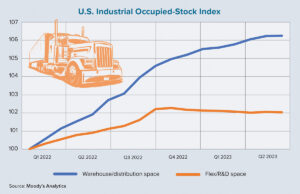The Great Lakes Region has long been the industrial heartland of the U.S. This region is comprised of six populous northern Midwest states: Illinois, Indiana, Michigan, Minnesota, Ohio and Wisconsin. A number of cities in this region are part of the so-called Rust Belt that struggled mightily due to the decline of the U.S. steel and auto industries in the 1970s as companies moved to other regions and countries.
Manufacturing and heavy industry, however, remain important employment sectors in these states, but the regional economy has evolved with a new emphasis on high tech, research and development. The coronavirus outbreak hit this region hard. This past April, the unemployment rate jumped to double digits in each of the Great Lakes states, except Minnesota. Prior to the outbreak, however, each of the state economies were growing. In terms of gross domestic product (GDP), Illinois and Ohio were the fifth- and seventh-largest economies last year among U.S. states.
 Annual GDP growth as of fourth-quarter 2019 ranged from 1.1% in Indiana to 2.3% in Michigan. Since 2010, the Great Lakes states have generally grown their populations, although Illinois is an exception. It was among 10 states that had a population decline between 2018 and 2019, according to the U.S. Census Bureau.
Annual GDP growth as of fourth-quarter 2019 ranged from 1.1% in Indiana to 2.3% in Michigan. Since 2010, the Great Lakes states have generally grown their populations, although Illinois is an exception. It was among 10 states that had a population decline between 2018 and 2019, according to the U.S. Census Bureau.
The economies of the Great Lakes states are less dependent on heavy manufacturing than they once were, but automaking remains a key industry in Michigan, Ohio, Indiana and Illinois. Michigan, particularly Detroit, is best known as the heart of the U.S. auto industry, although the state also is home to more than 160 aerospace product and parts manufacturing companies, including a significant carbon-fiber and composite-materials industry.
Illinois is a hub for Fortune 500 companies, including Deerfield-based Walgreens and Caterpillar, Boeing in Chicago and State Farm Insurance in Bloomington. Aside from farming and manufacturing, Indiana’s economy includes a developing biological-sciences industry. Insurance company Anthem and pharmaceutical company Eli Lilly and Co. are based in Indianapolis.
Ohio accounts for about 15% of the raw steel produced in the U.S. As of 2018, about 1,000 biotechnology-related companies directly or indirectly employed more than 100,000 people across the state. Centered in the Dayton area, aerospace is another important industry for Ohio.
Wisconsin is known for its farm commodities. It is the nation’s No. 1 cheese-producing state, making about 3.4 billion pounds annually. Wisconsin also is home base to Northwestern Mutual, ManpowerGroup and Kohl’s.
Minnesota companies manufacture chemicals, medical electronic devices and computer software. The Twin Cities of Minneapolis and Saint Paul house the headquarters for UnitedHealth Group, Target Corp. and U.S. Bancorp. •
Downtown Chicago Office Market
 Early this past May, Chicago’s economy had been severely disrupted in the wake of the COVID-19 outbreak, with stores and offices remaining largely closed. In first-quarter 2020, however, the central business district (CBD) office vacancy rate had only ticked up by 20 basis points year over year to 14.1%, while rents had increased to $41.02 per square foot, according to Cushman & Wakefield.
Early this past May, Chicago’s economy had been severely disrupted in the wake of the COVID-19 outbreak, with stores and offices remaining largely closed. In first-quarter 2020, however, the central business district (CBD) office vacancy rate had only ticked up by 20 basis points year over year to 14.1%, while rents had increased to $41.02 per square foot, according to Cushman & Wakefield.
In 2019, Chicago’s CBD office market saw its strongest year of leasing in a decade, with tenants absorbing a net of 1.7 million square feet. The leasing gains were driven primarily by an influx of tech and financial-services jobs into the city. Class A office space was in high demand last year, whereas older and lower-quality buildings had negative absorption.
Prior to the coronavirus outbreak, the outlook for the Chicago office market was positive, even with more than 6 million square feet of CBD office space under construction at the start of 2020. Record unemployment and the possible loss of thousands of office jobs, however, were causing property analysts to rethink their forecasts.
Focus: Auto manufacturing
The Great Lakes Region has long been the center of the U.S. auto-manufacturing industry. In spite of a decline from its heyday, Michigan is still home to 27 assembly plants and more than 2,200 facilities for automotive research, design, testing and other tasks, according to the Michigan Economic Development Corp.
General Motors and Ford Motor Co. each have their world headquarters in the Detroit metro area. Michigan’s auto plants produce about 20% of the vehicles produced in the U.S., more than any other state. The Wolverine State also is the source of three-quarters of the research and development that takes place across the North American auto industry..
Auto manufacturing also is a major employer in Illinois, Indiana and Ohio. In Ohio alone, Chrysler, Ford, Honda and General Motors have assembly plants. More than 1.1 million vehicles were built in the Buckeye State in 2018, with the industry directly employing 129,000 people and generating some $81 billion in economic output.
What the locals say
“Minneapolis-St. Paul is the economic driver for Minnesota. It is a very diverse economy with retail, health care, insurers, medical facilities and medical technology. General Mills and Hormel have a lot of operations facilities here. And then there is also manufacturing. In terms of migration, the Twin Cities definitely [attract] college students or recent college graduates, as well as the continued migration from other areas of the Midwest. So, all of those are driving factors for the continued strong economic growth. The Fortune 500 companies have deep roots in the community and they spin off a lot of smaller startup companies.”

Marsha Goff
Executive vice president, Merchants Capital
3 Cities to Watch
Detroit
 After years of decline that saw its population shrink by nearly one-third, Michigan’s most populous city filed for the largest municipal bankruptcy in history in 2013. In the years since, the fortunes of the city have been on the upswing. In 2018, Ford Motor Co. announced that it was buying an empty former train station, with plans to move 2,500 employees out of its Dearborn office into the 17-story, 1.2-million-square-foot building on the edge of downtown Detroit.
After years of decline that saw its population shrink by nearly one-third, Michigan’s most populous city filed for the largest municipal bankruptcy in history in 2013. In the years since, the fortunes of the city have been on the upswing. In 2018, Ford Motor Co. announced that it was buying an empty former train station, with plans to move 2,500 employees out of its Dearborn office into the 17-story, 1.2-million-square-foot building on the edge of downtown Detroit.
Cincinnati
 Cincinnati’s metro-area population of more than 2.2 million is the largest in Ohio. Originally settled in the late 1700s on the Kentucky-Ohio border and incorporated in 1819, Cincinnati grew into a major north-south trading hub on the Ohio River with the advent of the steamboat. Today, the city is home base for retail giant Kroger Co. and multinational consumer goods company Procter & Gamble.
Cincinnati’s metro-area population of more than 2.2 million is the largest in Ohio. Originally settled in the late 1700s on the Kentucky-Ohio border and incorporated in 1819, Cincinnati grew into a major north-south trading hub on the Ohio River with the advent of the steamboat. Today, the city is home base for retail giant Kroger Co. and multinational consumer goods company Procter & Gamble.
Minneapolis
 Along with neighboring St. Paul, Minneapolis is one half of the so-called Twin Cities that border the Mississippi River. The Twin Cities account for roughly 65% of Minnesota’s population and serve as the state’s economic hub. Notable for its extremely cold winters, Minneapolis has an intricate pedestrian skyway system that connects 80 city blocks in the downtown core, enabling people to walk to shops and businesses in a climate-controlled environment.
Along with neighboring St. Paul, Minneapolis is one half of the so-called Twin Cities that border the Mississippi River. The Twin Cities account for roughly 65% of Minnesota’s population and serve as the state’s economic hub. Notable for its extremely cold winters, Minneapolis has an intricate pedestrian skyway system that connects 80 city blocks in the downtown core, enabling people to walk to shops and businesses in a climate-controlled environment.
Sources: Cushman & Wakefield; Detroit Free Press; Encyclopedia.com; Forbes; Michigan Economic Development Corp.; Ohio Development Services Agency; Star Tribune; Statista; The Cincinnati Enquirer; The Detroit News; U.S. Bureau of Economic Analysis; U.S. Bureau of Labor Statistics; U.S. Census Bureau; U.S. Department of Labor; Trading Economics; WorldAtlas.com; World Population Review





